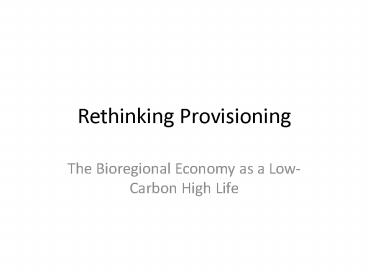Rethinking Provisioning PowerPoint PPT Presentation
Title: Rethinking Provisioning
1
Rethinking Provisioning
- The Bioregional Economy as a Low-Carbon High Life
2
Nature is not a place to visit, it is homeGary
Snyder
3
Why the globalised economy is unsustainable
- Extended supply chains
- Weakening of community bonds
- Climate change imposes limits on consumption and
transport
4
Why capitalism is unsustainable
- Extraction of value leads to more pressure on
resources - Work directed by profit rather than need
- Money-work nexus leads to debt-fuelled growth
5
- The critical argument now within environmental
circles is between those who operate from a
human-centered resource management mentality and
those whose values reflect and awareness of the
integrity of the whole of nature. (Snyder, 1990
194).
6
What is a bioregion?
- a unique region definable by natural (rather
than political) boundaries - A bioregion is literally and etymologically a
life-placewith a geographic, climatic,
hydrological and ecological character capable of
supporting unique human and non-human living
communities. Bioregions can be variously defined
by the geography of watersheds, similar plant and
animal ecosystems, and related identifiable
landforms and by the unique human cultures that
grow from natural limits and potentials of the
region
7
An economic bioregion
- A bioregional economy would be embedded within
its bioregion and would acknowledge ecological
limits. - Bioregions as natural social units determined by
ecology rather than economics - Can be largely self-sufficient in terms of basic
resources such as water, food, products and
services. - Enshrine the principle of trade subsidiarity
8
- We have forgotten that the economy and all
its works is a subset and dependent upon the
wider ecosystem. . . Modern citizens have not
only lost contact with the land, and their sense
of embeddedness in the land, but at the same time
they have lost those elemental social forms of
more or less intimate and relatively transparent
social relations. Thus a basic aim of
bioregionalism is to get people back in touch
with the land, and constitutive of that process
is the recreation of community in a strong sense.
(Barry, 1990 9).
9
Key characteristics of the bioregional economy
- Locality
- Accountability
- Community
- Conviviality
10
Locality but not autarky
- Cultural openness and maximisation of exchange
that can be achieved in a world of limited
energy, within a framework of self-sufficiency in
basic resources and the limiting of trade to
those goods which are not indigenous due to
reasons of climate or local speciality.
11
Accountability as reconnection
- Each bioregion would be the area of the global
economy for which its inhabitants were
responsibleif every local community protects its
own backyard, and especially if employees have
ownership and control of the own workplaces
through the expansion of worker co-operatives,
then we can expect higher levels of social and
environmental responsibility
12
Community not markets
- Reclaiming of public space for citizenship and
relationship. - putting the economy back in its place
- The agora is first and foremost a place of
public life and civil society
13
Conviviality instead of productivity
- I choose the term conviviality to designate the
opposite of industrial productivity. I intend it
to mean autonomous and creative intercourse among
persons, and the intercourse of persons with
their environment
- I believe that, in any society, as conviviality
is reduced below a certain level, no amount of
industrial productivity can effectively satisfy
the needs it creates among society's members.
(Illich, 1974).
14
Bioregional sheep sending a message from a Welsh
hillside
15
A Prototype Bioregion The Somerset Levels
16
Somerset Levels and Moors
- An area of 64,000 ha. lying to the South-West of
Bristol - The most significant grass wetland in England, a
coastal barrier of Levels (marine clays lying
on average only 6m. above sea level) and Moors
which can be as much as 6m. below peak tide
levels and prone to flooding - A specialised ecological system which has grown
up in parallel with human communities
17
Bioregional characteristics
- Wetland salvaged from
- the sea
- Typical species withy,
- rush and reed
- Typical crafts basket-making, furniture-making
- Other typical products dairy, apples and cider
- Annual cycle willow harvest, wassailing,
scything festival
18
A Bioregional Consumption Ethic
- Quality not quantity
- Embedding in the environment
- Borrowing resources from the local natural
environment - Celebration of the bioregion produits du
terroir, skills relevant to local production,
festivals of local wildlife
19
A Research Agenda
- How might bioregionalism help us re-embed our
economy? - How would economic bioregions be definedin terms
of watersheds or other natural features? - How does the way people think about their natural
world affect their economies? - What can bioregional consumption offer us in the
way of substitute identities?
20
A Research Project?

